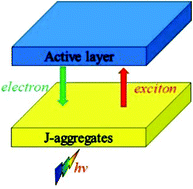Construction of J-type aggregates as multi-functional interlayers for nonfullerene polymer solar cells†
Abstract
We report a series of conjugated molecules containing an IDT/IDTT core and BI-H/NI-H end groups, which tend to self-assemble to supramolecular J-aggregates either directed by intermolecular multiple hydrogen bondings (IDT-BI-H, IDT-NI-H, IDTT-BI-H) or promoted by π–π interactions between the end groups of the adjacent molecules (IDTT-NI-H), as revealed by single-crystal structure analysis combined with spectroscopy studies. The J-aggregates absorb high energy visible light and convert to low energy delocalized excitons due to the coherent resonance of the transition dipoles of the monomers. The thin films of these J-aggregates are used as interlayers in inverted polymer solar cells between the ZnO layer and the active layers. The delocalized excitons in the J-aggregates transfer more energy to the active layer that compensates for the energy loss caused by the interlayer absorption, which results in quite similar external quantum efficiency (EQE) in the absorption region of the J-aggregates (400–550 nm). Furthermore, some of these J-aggregates show enhanced electron collecting and transporting properties that result in obviously increased EQE in 550–750 nm, which might be attributed to the improved contact between the interlayers and electron acceptor ITIC for similar A–D–A type molecular structures. The results clearly indicate the promising strategy for high performance interlayers by designing J-aggregates of dye molecules.



 Please wait while we load your content...
Please wait while we load your content...